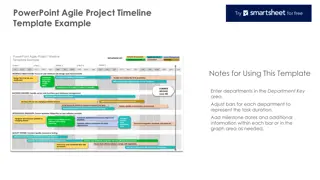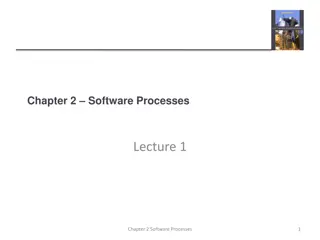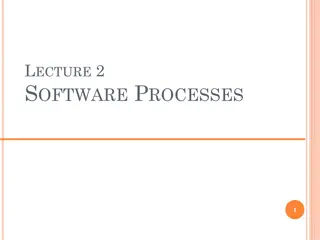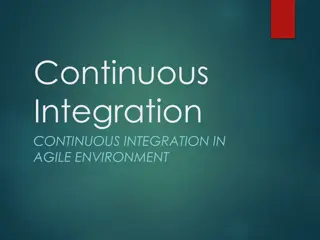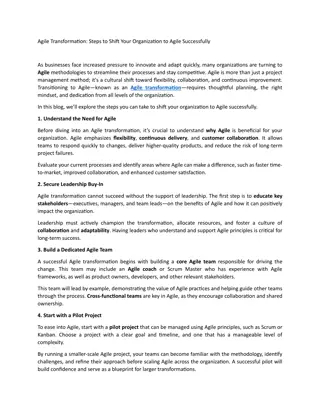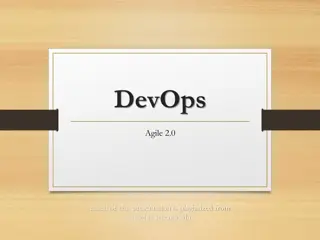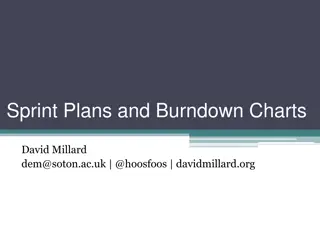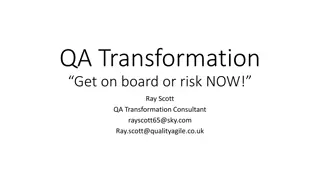Agile User Stories in Software Development
Agile user stories play a crucial role in software development by providing short descriptions of features desired by customers in a language they understand. This method allows for agile planning, efficient documentation, and effective communication between development teams and clients. Extracting user stories may require brainstorming and visual modeling to ensure clarity and understandability. Through elements such as language clarity, end-to-end considerations, and testability, good user stories can enhance the development process. The session delves into the process of developing user stories and understanding their importance in agile methodologies.
Download Presentation

Please find below an Image/Link to download the presentation.
The content on the website is provided AS IS for your information and personal use only. It may not be sold, licensed, or shared on other websites without obtaining consent from the author.If you encounter any issues during the download, it is possible that the publisher has removed the file from their server.
You are allowed to download the files provided on this website for personal or commercial use, subject to the condition that they are used lawfully. All files are the property of their respective owners.
The content on the website is provided AS IS for your information and personal use only. It may not be sold, licensed, or shared on other websites without obtaining consent from the author.
E N D
Presentation Transcript
The problem with documentation Argument: Heavy documentation too much for most business-style projects
English Documentation Can be ambiguous (one reason for more formal documentation styles, e.g. ER diagram instead of English) The man who hunts ducks out on weekends Fat people eat accumulates We painted the wall with cracks This agreement shall be effective from the date it is made and shall continue in force for a period of five (5) years from the date it is made, and thereafter for successive five (5) year terms, unless and until terminated by one year prior notice in writing by either party.
Agile User Stories Short descriptions of feature(s) the customer would like to see in their software Usually fits on an index card
Elements of Good User Stories In language the customer understands Cuts end-to-end through layers of the architecture Independent of other user stories (as much as possible) Are negotiable, tradeoffs possible Are testable Are small and estimable
Extracting User Stories May need to do lots of brainstorming, draw lots of pictures, model the workflow
In-Class Exercise I am the client and all of you are the development team Help develop user stories for a thin section photomicrograph pixel counter
Check Stories Check INVEST Independent, Negotiable, Valuable, Estimable, Small, Testable Can something be re-cast as a constraint? E.g. Must be fast to Must load within 2 seconds Scrub list, look for duplicates, consolidation or splitting of user stories
Analysis and Estimation You now have a stack of user stories Identify stories that require clarification Next we want to estimate how long they will take
Relative Estimation Estimate coding time required for each story, but not in actual time, but in units . Joshua Kerievsky uses NUTs: Nebulous Units of Time Idea is to convey the relative sizes of stories Tough to do because you don t know what units represent until a few iterations are done, but they will shape up as time goes on
Estimation Humans are better at relative than absolute estimation Agile estimation is to size our stories relative to each other and keep track of time taken
Units of Time Say a story we estimated to take 3 days really took 4 days We could adjust actual calendar days to programming days by multiplying programming days by 1.333 Endless rejiggering? False precision?
Point System Can avoid problems by using a point system Focus on relative sizes of the stories Reminds us that estimates are guesses Measure of pure size Simple
Estimating Stories To estimate the user stories it may help to break them into tasks; discrete steps to complete the story E.g. to save a document, you may have the task of creating the GUI to initiate the task, another task for the disk operation Brainstorm with your team for an estimate of units Tasks aren t shared with the client
In-Class Exercise Estimate units for thin section pixel counter user stories
Estimating NUTS If you have the same amount of time to devote to the project every week you don t need to convert to person-hours; you can just use NUTS/iteration as your velocity Go to client and say how many NUTS you estimate you can do the first week based on the perceived difficulty
Determining Workload Clients are initially not happy to get estimates in terms of units Client: What s a unit? Developers: We don t know. Client: How many units can you do this week? Developers: We don t know, but we can make an initial estimate, and it will get better every iteration and even within an iteration. If you estimated 20 NUTS the first iteration but you only completed 10 NUTS then you can generate a better estimate for the second iteration Project spike useful here to get an initial estimate Project velocity = NUTS completed / iteration
Estimating NUTs from Person Hours If your time varies each week estimate for the first iteration how many person-hours the group can collectively commit per week Allow for time when you re not coding and not working Make an estimate; the next one can be better Go to client and say how many units you can do per week Consider how many people you have and how many hours each person can actually work After the iteration is over you can make an estimate of units per hour E.g. if 20 person hours and you were able to do 20 units per week then 1 unit/hour
Client Reevaluation Give client the user stories, estimates, and the total number of units you can do per week Client gets to pick the stories that add up to the total number of units Client doesn t get to add more stories beyond the total number of units Important not to let the client get away with this, remind the client they can do different stories the next iteration Have to prioritize and drop something if another being added
In-Class Exercise Estimate total units per week (optional to map from hours) for the thin section pixel counter project Client to prioritize
Dealing with Disappointment After a week perhaps you see your estimates weren t accurate Usually programmers underestimate the time required Reassess where you are with your group and immediately go to the client so he or she can determine how you should spend your remaining time Sometimes this is good news If you only got to finish 10 units and you estimated 40, then you have better data for the next iteration Estimates should get better each iteration; surprises are early, not later
Rinse and Repeat Even if you didn t complete as many stories as estimated the first iteration, the client should be happy with your honesty As the project progresses you should get better at knowing what you can do in an iteration Continue to keep the client informed and track where you are at all times Client may be unhappy the product is going slowly, but it s hard to argue with the data you are gathering and sharing
Communication Use BlackBoard wiki or forum to share information with your team members Good place to keep track of Meeting notes Issues or problems Assigned tasks, estimates, actual time taken Compare with actual time
Rules 1. The developers will be truthful in their estimates and the customers will believe these estimates 2. The developers will refine their estimates and the customers will refine their expectations based on the actual achievements in each iteration 3. During the iteration the developers will update the client as to the progress of the iteration. The client will use this information to quickly refine what is required in the current iteration.
Summary of Agile Planning every Iteration Develop user stories with client Without client, break users stories into tasks to better understand time it will take to complete Assign NUTs to each user story Estimate how many NUTs the group can complete in one iteration May require conversion from Hours to NUTs Ask the client to prioritize user stories for the current iteration; must fit within NUTs the group can complete in the iteration! Show client your work at the end of iteration Repeat with modified estimate for NUTs the group can complete




